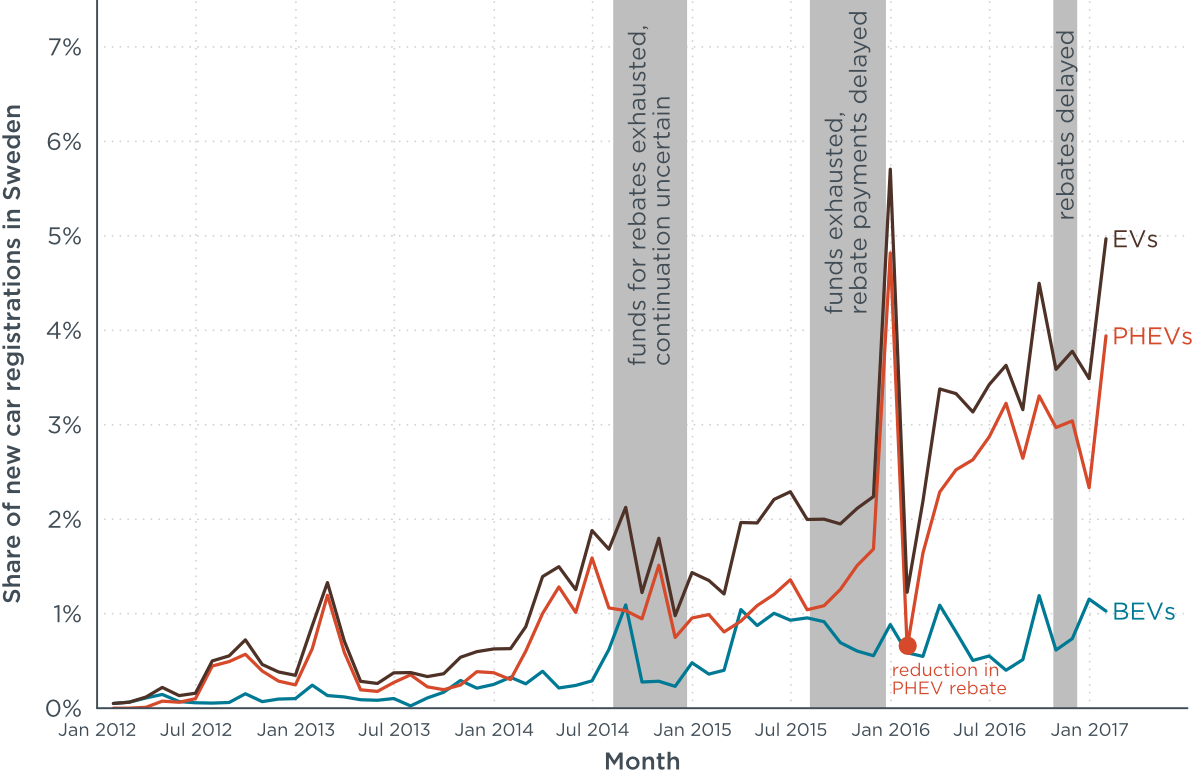Blog
Lessons learned from Sweden’s electric vehicle rollercoaster
Sweden is a rising star in the electric vehicle (EV) world. Thanks to a combination of progressive policies and favorable market conditions, Sweden is following in the EV tracks of its trailblazing neighbor Norway, and the country will have to continue to do so: Sweden’s new climate change bill (don’t miss how it was signed) calls for a 70% reduction of greenhouse gas emissions in the transportation sector by 2030. To meet this target, passenger cars will have to be decarbonized—and fast—but Sweden’s history of inconsistent incentives for EVs could slow progress.
Just signed referral of Swedish #climate law, binding all future governments to net zero emissions by 2045. For a safer and better future. pic.twitter.com/OqOO2y8BU6
— Isabella Lövin (@IsabellaLovin) February 3, 2017
The so-called “super green car rebate” (supermiljöbilspremie) is the backbone of Sweden’s EV policies. EV buyers receive a 40,000-kroner rebate (roughly 4,200 euros) for new cars that emit no more than 50 grams of carbon dioxide per kilometer. In practice, this means that battery electric vehicles (BEVs) and most plug-in hybrid electric vehicles (PHEVs) are eligible for the rebate, although it was halved for PHEVs in 2016.
When the rebate was introduced in 2012, it was designed to cover 5,000 low-carbon vehicles. Sweden reached this threshold in mid-2014, but extended the program in 2014, 2015, and 2016, which brings us to the rebate program’s Achilles heel: dependability.
For each year mentioned above, the Swedish government budgeted a fixed amount of funds for the rebate. This budget would invariably be exhausted before the government decided to extend the program. In other words, the funds were flowing into the market at a faster rate than the Swedish government would replenish them.
To make matters worse, Swedish EV buyers do not receive the rebate at the point of sale. Instead, the Swedish Transport Agency monitors EV registrations and contacts new EV owners. After EV owners submit paperwork, they receive the rebate.
The combination of insufficient funding and the wait time for new owners between purchasing an EV and receiving the rebate interrupted the rebate program three times. During these months-long interruptions, more EVs had been sold than the government had budgeted rebates for, leaving new and potential EV owners wondering when they would receive the rebate, or worse yet, if they would receive it at all.
The chart below plots monthly market shares of BEVs and PHEVs from January 2012 to January 2017 and highlights interruptions in the rebate program. During this time, annual EV shares (BEVs and PHEVs together) increased from 0.3% in 2012 to 3.6% in 2016, with PHEVs generally outnumbering BEVs by a factor of about 2.5.

Monthly market data are always noisy, which is why we would typically plot a rolling mean rather than monthly developments (see our blog on the German EV market). But some of the abrupt fluctuations in the graph illustrate why stable policy signals are important.
The first disruption of the rebate program began on August 8, 2014, when the Swedish Transport Agency announced that funds for the rebate program were about to run out and the future of the rebate was uncertain. After that, the EV market share dropped noticeably, from a 2014 peak of 2.1% in August to a less than half that in November. The interruption ended on December 22, 2014, when the agency announced that new funding had been secured and the rebate would continue into 2015.
EV registrations recovered during the first half of 2015, growing to roughly 2% of the new car market. Then, on August 5, 2015, the Swedish Transport Agency again announced that funds had been depleted, although this time the agency also said that that the program would continue in 2016. Four months later, on December 23, new funding was announced, but EV market shares had stagnated while potential buyers waited for the new funding.
The December 2015 announcement also introduced a change in the rebate: the rebate would be halved for PHEVs beginning in 2016. This announcement led to a sudden increase in PHEV registrations in December 2015, peaking at 4.8%, followed by the inevitable crash of the PHEV market in January 2016 to only 0.6%.
The third interruption occurred on October 26, 2016, when the Swedish Transport Agency again announced a shortage in funding. New funding was secured by December 9, but the comparatively short break in funding coincided with rapid fluctuations in EV registrations. Shortly after the last interruption, the Swedish government extended the rebate program once again into 2017.
This is not to say that the rebate program doesn’t work—it does. With a 3.6% market share in 2016, Sweden places fourth among European EV markets, after Norway, the Netherlands, and Iceland. But this rollercoaster—sudden breaks in funding triggering equally sudden drops in market shares—could be avoided. Although monthly fluctuations do not matter per se, the graph shows that potential EV owners were holding off on buying EVs during periods of uncertainty. In short, we could be seeing more EVs on Swedish roads if the rebates had been more reliable.
One way to ensure stable funding for EVs is using a so-called feebate program (see this blog for an illustration of feebates or play around with our free feebate tool). Feebate programs combine fees and rebates, penalizing high-emitting vehicles with taxes while providing rebates to low-carbon vehicles. Because the taxes create revenue that can be used to incentivize clean vehicles, feebate programs present an ideal policy option for dependable EV incentives.
The Swedish government is planning to introduce a feebate program in 2018 (see the proposal or this summary, both in Swedish), which aims to ensure sustainable financing and reassure potential EV buyers. Although the feebate program will likely bring an end to the EV market rollercoaster, other countries can learn a valuable lesson from the Swedish rebate program: dependable policies are key to steady EV market growth.
